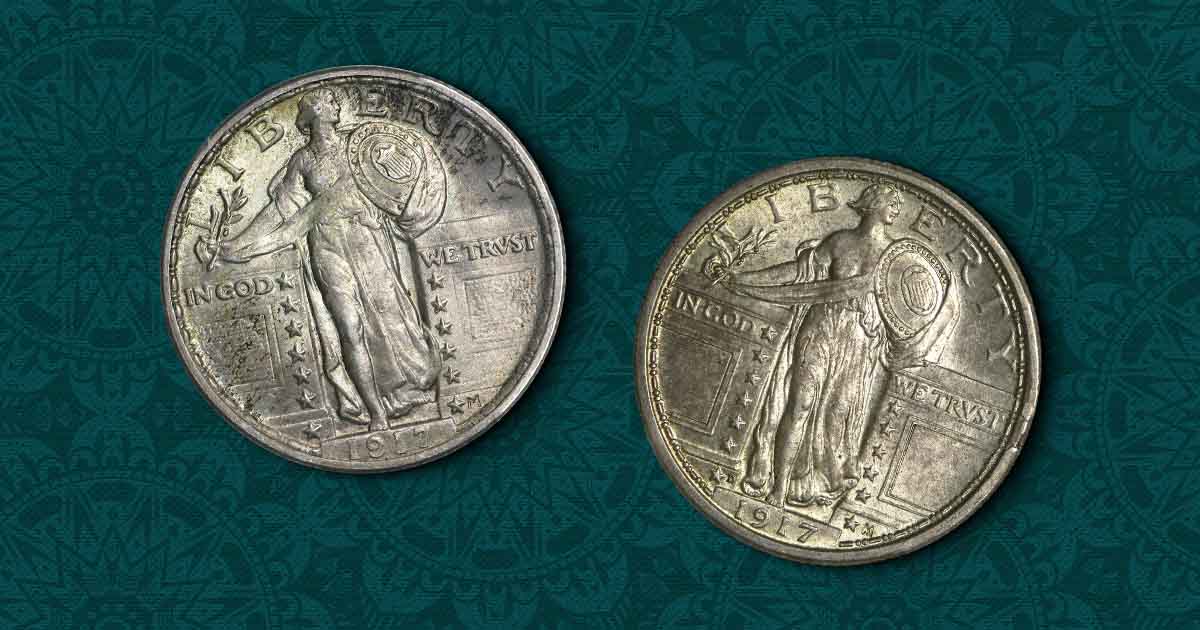
The Full Head designation describes the quality of strike found on the Standing Liberty quarter designed by Hermon A. MacNeil and minted from 1916 to 1930. Liberty’s depiction on this coin showcases intricate details in her hair, especially the area above her forehead.
Attaining a “Full Head” designation signifies that these details remain sharp in appearance and are not worn out or flattened due to circulation.
Variations in the Standing Liberty Series
The Standing Liberty quarter saw two primary variations in its series: Type 1 and type 2.
Type 1 Standing Liberty Quarters
The obverse of the type 1 Standing Liberty depicts a right bare breast on Liberty. The reverse of the type 1 has an eagle that is low on the design.
Type 2 Standing Liberty Quarters
The obverse of the type 2 Standing Liberty quarter depicts Liberty in a chainmail shirt covering her torso. On the reverse of the type 2 Standing Liberty quarter, the eagle is centered, and three stars have been added below the eagle.
How Grading Organizations Grade the Full Head
Various grading services, such as PCGS (Professional Coin Grading Service) and NGC (Numismatic Guaranty Corporation), have established their own criteria for evaluating the Full Head designation.
PCGS Standards for Full Head Standing Liberty Designations
PCGS considers the Full Head designation for Standing Liberty quarters graded AU-50 or greater. The criteria involve a meticulous evaluation of the hair details, requiring a coin to display complete and sharp lines in the hair to receive the Full Head designation.
For a type 1 Standing Liberty quarter (1916-1917) to achieve a Full Head designation from PCGS, there must be a distinct and clear separation between the cap and hair chords on Liberty’s head.
For type 2 Standing Liberty quarter to obtain a Full Head designation from PCGS, there is a little bit more required. Liberty’s helmet must display three complete leaves and a clearly defined ear hole in Liberty’s head, as well as a full outline of the bottom of Liberty’s helmet.
There is an exception made for the rare Standing Liberty 1918/7-S date. For that variety, PCGS appoints a Full Head designation to Standing Liberty quarters that meet the type 2 standards for Standing Liberty Quarters graded XF-40 or greater.
NGC Standards for Full Head Standing Liberty Designations
NGC assesses the Full Head designation for Standing Liberty quarters, with a specific focus on the hair above Liberty’s forehead.
To qualify for the designation, the coin must exhibit clear and complete details with three leaves in Liberty’s hair, as well as a clear hairline along her brow. The ear indentation must be clear as well.
The relative rarity of the Full Head designation can vary based on the issue and year of the Standing Liberty quarter. Generally, coins with the Full Head designation are deemed more desirable among collectors. The complexity of the design and the vulnerability of the high points to wear during circulation contribute to the rarity of coins with well-preserved details in the hair.
Collectors actively seek coins with the Full Head designation because they represent examples that have endured in better condition, showcasing the original artistry of the minting process. The rarity adds to the appeal and value for numismatists who appreciate the beauty and historical significance of these coins.
Collecting Standing Liberty Quarters
The Standing Liberty quarter was minted from 1916-1930 and featured Liberty portrayed like a Greek goddess holding a shield and an olive branch. The Standing Liberty quarter preceded the Washington quarter series.





